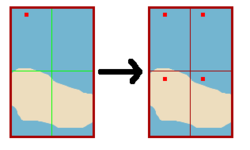Difference between revisions of "Half-graticule"
From Geohashing
imported>Phyzome (change image size (purge)) |
imported>Phyzome (ramifications section) |
||
| Line 2: | Line 2: | ||
[[Image:Half-grat.png|thumb|right|250px|Diagram of the approach]] | [[Image:Half-grat.png|thumb|right|250px|Diagram of the approach]] | ||
| + | |||
| + | == Details == | ||
# Take (a,b) as the standard decimal location. | # Take (a,b) as the standard decimal location. | ||
| Line 11: | Line 13: | ||
## (c + 0.5, d + 0.5) | ## (c + 0.5, d + 0.5) | ||
| − | One of those is guaranteed to match (a, b), but one of the other three may be ''more accessible''. | + | One of those is '''guaranteed to match''' (a, b), but one of the other three may be ''more accessible''. |
| + | == Ramifications == | ||
| + | Would this lead to fragmenting of the geohash community? Perhaps not, since anyone using this technique would likely not be able to make it to the standard coordinates. This approach merely serves as a way of deterministically generating alternate meetup locations when the standard one is unreachable. | ||
[[Category:Alternate algorithm]] | [[Category:Alternate algorithm]] | ||
Revision as of 18:53, 12 June 2008
People in graticules or regions severely restricted by water might consider a modification to the algorithm that will still coincide with the standard coordinates.
Details
- Take (a,b) as the standard decimal location.
- Take (c, d) = (a % 0.5, b % 0.5) as the half-size location. (% is the mod operator)
- New locations:
- (c, d)
- (c + 0.5, d)
- (c, d + 0.5)
- (c + 0.5, d + 0.5)
One of those is guaranteed to match (a, b), but one of the other three may be more accessible.
Ramifications
Would this lead to fragmenting of the geohash community? Perhaps not, since anyone using this technique would likely not be able to make it to the standard coordinates. This approach merely serves as a way of deterministically generating alternate meetup locations when the standard one is unreachable.
